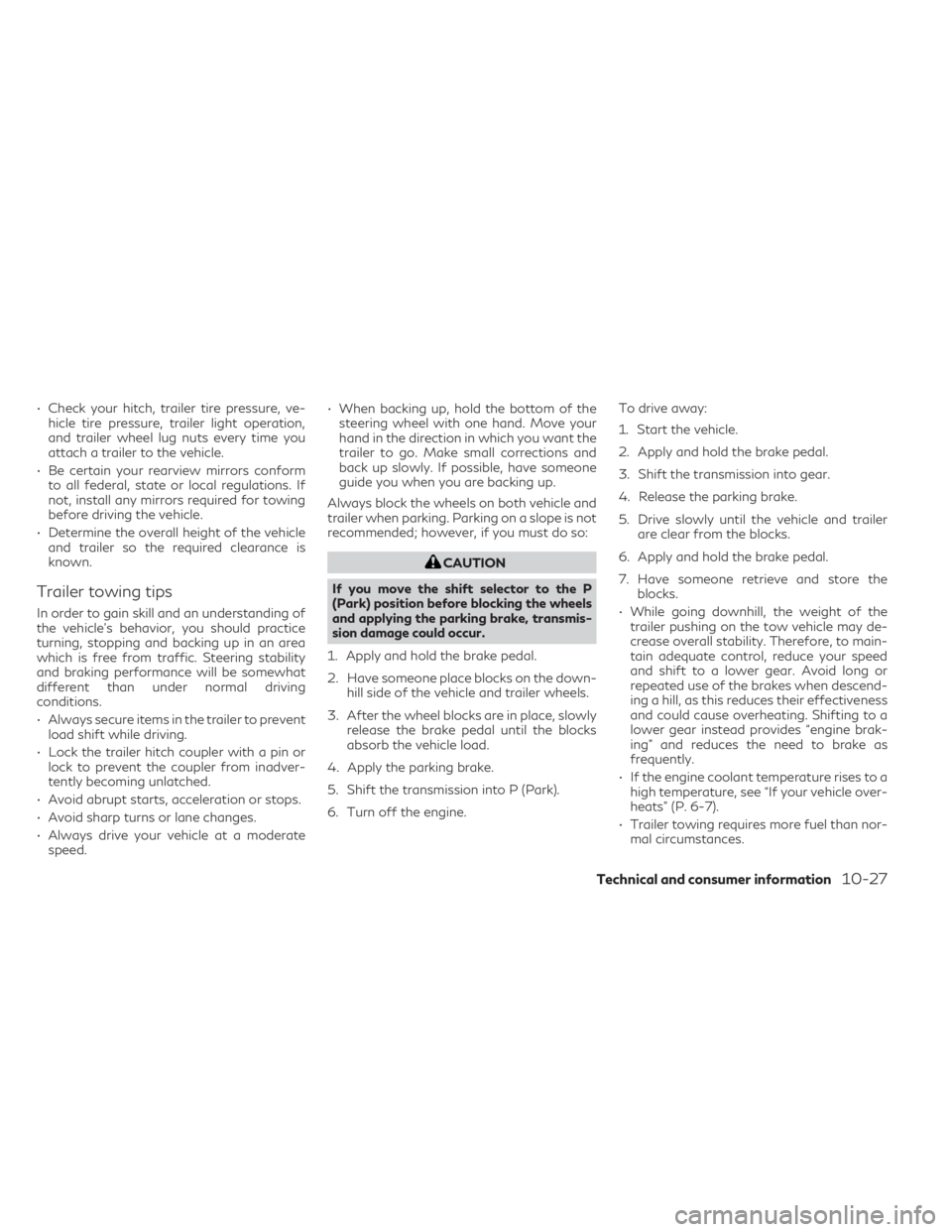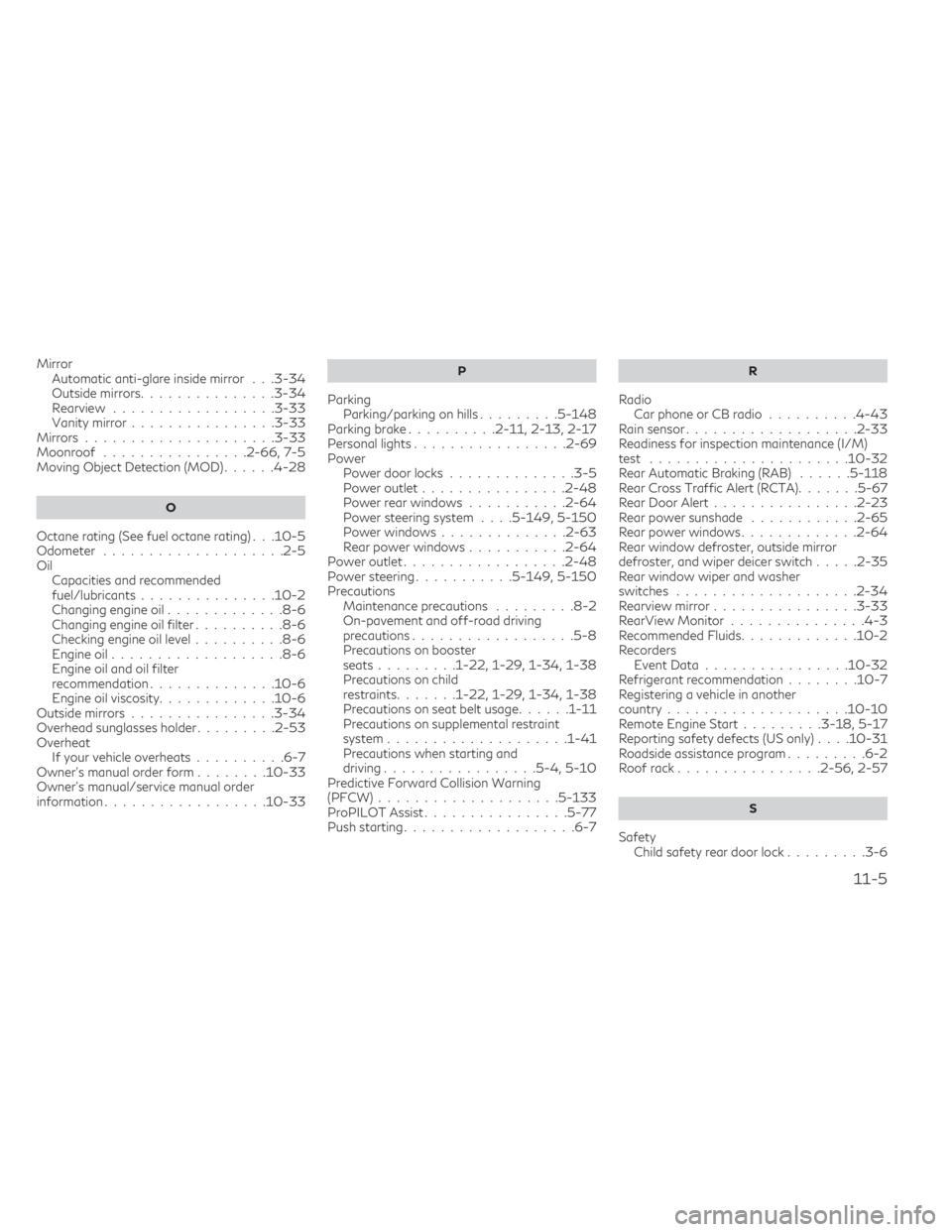rear view INFINITI QX50 2021 Owner's Guide
[x] Cancel search | Manufacturer: INFINITI, Model Year: 2021, Model line: QX50, Model: INFINITI QX50 2021Pages: 542, PDF Size: 3.51 MB
Page 402 of 542

The sonar system sounds a tone to inform the
driver of obstacles near the bumper.
When the sonar system is turned on, the
sonar view will automatically appear in the
center display when the camera is activated.
WARNING
Failure to follow the warnings and instruc-
tions for proper use of the sonar system
could result in serious injury or death.
• The sonar system is not a replacement
for proper driving procedures and is not
designed to prevent contact with ve-
hicles or objects. •
The driver is always responsible for
safety during parking and other maneu-
vers. Always look around and check that
it is safe to do so before parking.
• This function is designed as an aid to the
driver in detecting large stationary ob-
jects to help avoid damaging the vehicle.
If your vehicle sustains damage to the bumper
fascia, leaving it misaligned or bent, the sensing
zone may be altered causing inaccurate mea-
surement of obstacles or false alarm.
CAUTION
•
Excessive noise (such as audio system vol-
ume or an open vehicle window) will inter-
fere with the tone and it may not be heard.
• Keep the sonar sensors (located on the
bumper fascias) free from snow, ice and
large accumulations of dirt. Do not clean
the sensors with sharp objects. If the
sensors are covered, the accuracy of the
sonar function will be diminished.
SYSTEM OPERATION
The system informs with a visual and audible
signal of front obstacles when the shift lever
is in the D (Drive) position and both front and
rear obstacles when the shift lever is in the R
(Reverse) position.
LSD3923LSD2993
FRONT AND REAR SONAR SYSTEM
(if so equipped)
5-160Starting and driving
Page 523 of 542

• Check your hitch, trailer tire pressure, ve-hicle tire pressure, trailer light operation,
and trailer wheel lug nuts every time you
attach a trailer to the vehicle.
• Be certain your rearview mirrors conform to all federal, state or local regulations. If
not, install any mirrors required for towing
before driving the vehicle.
• Determine the overall height of the vehicle and trailer so the required clearance is
known.
Trailer towing tips
In order to gain skill and an understanding of
the vehicle's behavior, you should practice
turning, stopping and backing up in an area
which is free from traffic. Steering stability
and braking performance will be somewhat
different than under normal driving
conditions.
• Always secure items in the trailer to preventload shift while driving.
• Lock the trailer hitch coupler with a pin or lock to prevent the coupler from inadver-
tently becoming unlatched.
• Avoid abrupt starts, acceleration or stops.
• Avoid sharp turns or lane changes.
• Always drive your vehicle at a moderate speed. • When backing up, hold the bottom of the
steering wheel with one hand. Move your
hand in the direction in which you want the
trailer to go. Make small corrections and
back up slowly. If possible, have someone
guide you when you are backing up.
Always block the wheels on both vehicle and
trailer when parking. Parking on a slope is not
recommended; however, if you must do so:
CAUTION
If you move the shift selector to the P
(Park) position before blocking the wheels
and applying the parking brake, transmis-
sion damage could occur.
1. Apply and hold the brake pedal.
2. Have someone place blocks on the down- hill side of the vehicle and trailer wheels.
3. After the wheel blocks are in place, slowly release the brake pedal until the blocks
absorb the vehicle load.
4. Apply the parking brake.
5. Shift the transmission into P (Park).
6. Turn off the engine. To drive away:
1. Start the vehicle.
2. Apply and hold the brake pedal.
3. Shift the transmission into gear.
4. Release the parking brake.
5. Drive slowly until the vehicle and trailer
are clear from the blocks.
6. Apply and hold the brake pedal.
7. Have someone retrieve and store the blocks.
• While going downhill, the weight of the trailer pushing on the tow vehicle may de-
crease overall stability. Therefore, to main-
tain adequate control, reduce your speed
and shift to a lower gear. Avoid long or
repeated use of the brakes when descend-
ing a hill, as this reduces their effectiveness
and could cause overheating. Shifting to a
lower gear instead provides “engine brak-
ing” and reduces the need to brake as
frequently.
• If the engine coolant temperature rises to a high temperature, see “If your vehicle over-
heats” (P. 6-7).
• Trailer towing requires more fuel than nor- mal circumstances.
Technical and consumer information10-27
Page 535 of 542

MirrorAutomatic anti-glare inside mirror. . .3-34Outside mirrors.............. .3-34Rearview................. .3-33Vanity mirror................3-33Mirrors.................... .3-33Moonroof................2-66, 7-5Moving Object Detection (MOD)......4-28
O
Octane rating (See fuel octane rating). . .10-5Odometer................... .2-5Oil
Capacities and recommended
fuel/lubricants
.............. .10-2Changing engine oil.............8-6Changing engine oil filter..........8-6Checking engine oil level..........8-6Engine oil.................. .8-6Engine oil and oil filter
recommendation..............10-6Engine oil viscosity.............10-6Outside mirrors............... .3-34Overhead sunglasses holder.........2-53Overheat
If your vehicle overheats..........6-7Owner's manual order form........10-33Owner's manual/service manual order
information................. .10-33
P
Parking
Parking/parking on hills.........5-148Parking brake..........2-11, 2-13, 2-17Personal lights................ .2-69Power
Power door locks............. .3-5Power outlet............... .2-48Power rear windows...........2-64Power steering system. . . .5-149, 5-150Power windows............. .2-63Rear power windows...........2-64Power outlet................. .2-48Power steering...........5-149, 5-150Precautions
Maintenance precautions.........8-2On-pavement and off-road driving
precautions................. .5-8Precautions on booster
seats.........1-22, 1-29, 1-34, 1-38Precautions on child
restraints.......1-22, 1-29, 1-34, 1-38Precautions on seat belt usage......1-11Precautions on supplemental restraint
system................... .1-41Precautions when starting and
driving.................5-4, 5-10Predictive Forward Collision Warning
(PFCW)................... .5-133ProPILOT Assist................5-77Push starting.................. .6-7
R
Radio
Car phone or CB radio..........4-43Rain sensor.................. .2-33Readiness for inspection maintenance (I/M)
test..................... .10-32Rear Automatic Braking (RAB)......5-118Rear Cross Traffic Alert (RCTA).......5-67Rear Door Alert................2-23Rear power sunshade............2-65Rear power windows............ .2-64Rear window defroster, outside mirror
defroster, and wiper deicer switch.....2-35Rear window wiper and washer
switches................... .2-34Rearview mirror................3-33RearView Monitor...............4-3Recommended Fluids.............10-2Recorders
Event Data............... .10-32Refrigerant recommendation........10-7Registering a vehicle in another
country................... .10-10Remote Engine Start.........3-18, 5-17Reporting safety defects (US only). . . .10-31Roadside assistance program.........6-2Roof rack................2-56, 2-57
S
Safety
Child safety rear door lock.........3-6
11-5